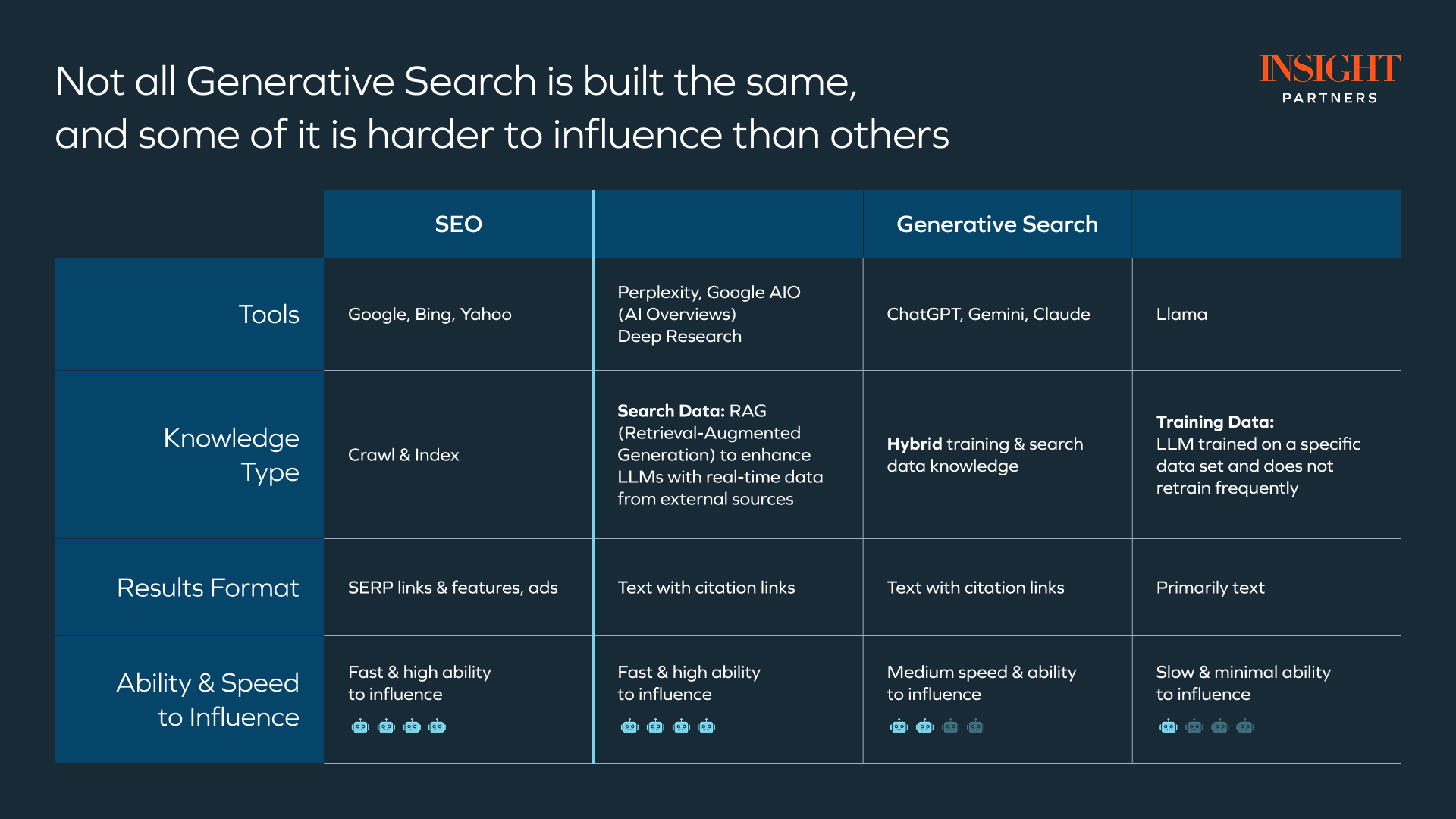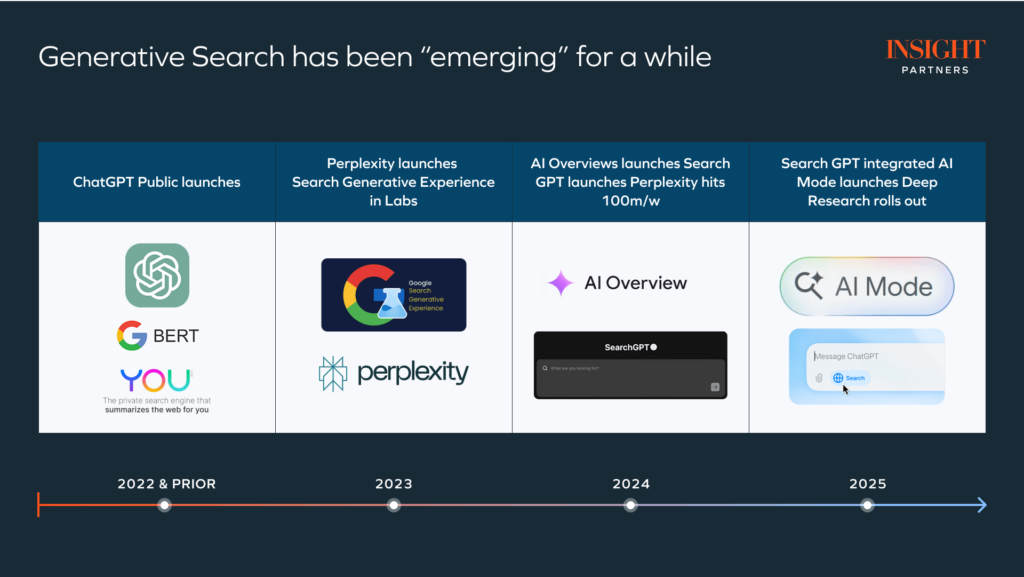Across our portfolio, we’re seeing the same trends on inbound traffic: a drop in clicks, fewer leads from search, and a growing sense of confusion about what’s working and how GTM should evolve.
“You just have to look at the screen real estate,” says Neal Behrend, GTM expert on Insight’s Onsite team. “When you compare Google in 2022 to AI Mode in 2025, it’s obvious why traffic is going down.”
LLMs don’t care about your rankings
In the old SEO world, your goal was simple: Rank for keywords, earn clicks. However, generative search requires a different approach.

“There is a new marketing tactic emerging that influences LLM responses — period, no traffic required,” Behrend says.
And it has two parts:
- Answer optimization: Shape what the AI says about your product, category, or space.
- Citation optimization: Ensure your content is the source the AI references in its response.
This is no longer just about being on page one — it’s about being the answer.
A 4-part framework for founders: Measure your exposure
Behrend recommends founders start with four key diagnostics:
- Search dependency “32% of marketing-sourced pipeline across Insight’s portfolio comes from SEO and paid search,” Behrend shares. “If that’s true for you, this is a critical issue.”
- ICP adoption of generative search: Your vulnerability depends on how your buyers are searching. Targeting developers for your new feature? High risk. Traditional manufacturing buyers? Less so. Almost 50% of Insight portfolio marketing leaders admitted to not knowing their customers’ adoption of generative search. Use tools like SparkToro or Pew data to estimate it.
- Keyword and topic vulnerability: What you rank for today might already be buried under AI Overviews. Audit your top keywords and check how they appear in tools like ChatGPT or Perplexity.
- Content quality and authority: Is your content being cited in generative responses? “If you’re not showing up in mentions or citations, you’re not in the conversation,” Behrend says.
What to do now: Insight’s 3-step playbook
1. Identify your most important queries
Split them into two categories:
- Informational queries: Jobs to be done, pain points, and use cases. You likely won’t be named in the answer, but citations here drive credibility and traffic. They also give you the springboard to shape the conversation.
- Category queries: What your buyers search for when evaluating products. This is where mention rate and positioning really matter. Positioning is about more than just being the first product mentioned; it’s about being presented with the same strengths you portray in your marketing.
2. Track and report the right metrics
Don’t let your marketing team “wing it.” Founders should expect a report that includes:
- Pipeline from search: This tells you whether generative search is a short-term challenge — or a long-term existential threat.
- Traffic from generative tools: Use GA4 to track traffic from ChatGPT, Perplexity, and Gemini. The key is to focus on quarter-over-quarter growth to understand how fast this shift is happening.
- AI Overview coverage rate: Are your priority keywords being answered by AI Overviews? Are the boxes expanded and reducing traffic to websites? If so, your organic visibility is under threat. Your traditional SEO tracking tools should have some of this information available.
- Citation and mention rate: How often are you cited in answers across generative platforms? You can’t improve what you’re not measuring. For this, you need AI visibility tracking tools. Profound and Ziptie are emerging here, but traditional SEO data providers (SEMRush, Similarweb, etc.) are quickly adding capabilities (for additional cost).
- Your active experiments: “We’re in the white-text-on-white-background era of generative SEO,” Behrend explained. “There’s no gold standard yet. But the companies running active tests are the ones learning fastest.”
Insight provides templates for generative search-specific reporting across the portfolio. If you don’t have one or don’t know the best tools for tracking these metrics, comment below and we’ll DM you.xf
3. Run controlled experiments — and share learnings
Behrend is seeing most testing fall into one of four areas where Insight is seeing traction:
- Technical Improvements: Add FAQ schema. Simplify H1/H2 structure. Minimize JavaScript. LLMs.txt is getting a lot of press but has not been well adopted by crawling bots.
- Content strategy: Focus on original data or unique viewpoints that are hard to summarize or copy without providing citations.
- Content type: Question and answer format, with declarative statements as answers. Query matching to user intent. Using citations of your own to demonstrate high authority.
- Off-page visibility: Determine the LLMs’ “media diet.” Find what sources LLMs trust — and get mentioned there. “This is the old-school backlinking game, but without the link. You just need the mention. A 15-minute briefing for a top content producer with your CEO can land you a top spot in ChatGPT,” says Behrend.
“We are so early with generative search that doing the simplest things can have a big impact.”
Looking ahead: The rise of the agent
What happens when your buyer never even sees your website?
Behrend believes we’re approaching the era of agentic search, where AI agents — not humans — filter what’s worth seeing, reading, and engaging with:

In that future, message consistency and content saturation become survival skills. LLMs are stochastic machines; they surface what is said most often and most authoritatively. If you’re inconsistent or invisible, you’ll be skipped. Behrend will be hosting a future Onsite Hour on this topic.
Founders: This is a moment of leverage
You don’t need to solve everything at once. But you do need to act. Start by asking your marketing team:
- How does our buyer search? Do they use generative search?
- What are our top queries?
- Where are we visible in generative search?
- How are we trying to influence citations and answers?
- What tools and experiments are we running?
- What’s the LLMs media diet for our queries — who’s influencing the LLMs?
Access Insight’s generative search-specific reporting template.










